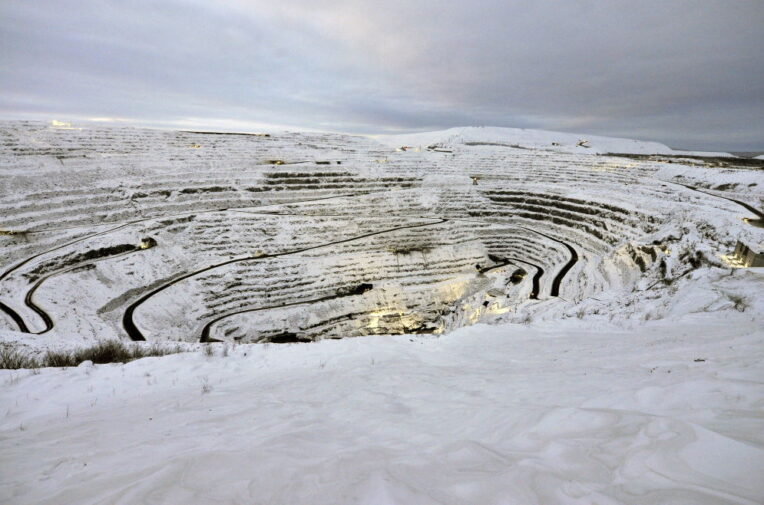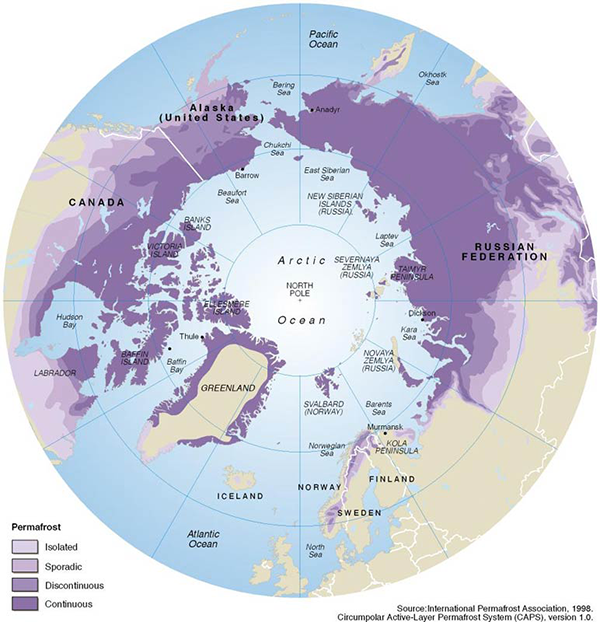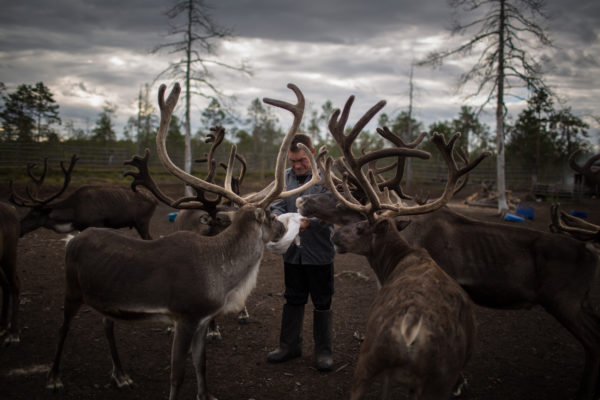De
opwarming van het Arctisch gebied kan besmettelijke ziekten doen
vrijkomen uit de permafrost: vorige week werd daar een record
temperatuur gemeten van 45 graden Celsius.....
Gisteren
kwam Unearthed (onderdeel Greenpeace) met een verontrustend artikel
over de voortdurende hittegolf in het arctisch gebied, waar de
temperatuur in het noorden 38 graden Celsius hoog was en de
landtemperatuur zelfs de 45 graden C. aantikte, een temperatuur
die men zelfs in Groot-Brittannië nooit heeft gemeten (en ik dacht
ook niet in ons land of andere ons omliggende landen)
Een
ernstige zaak daar door die hoge temperaturen de permafrost veel
sneller ontdooit dan de gemiddelde wetenschapper ooit heeft durven
dromen (nachtmerrie)..... Vandaar ook dat een intussen flink aantal
wetenschappers ervan overtuigd is dat de temperatuur aan het einde
van deze eeuw zelfs de 3 graden Celsius fiks te boven zal gaan......
Dit zal tot gevolg hebben dat gesmolten ijs en sneeuw van de beide
polen de zeespiegel zover zal doen stijgen dat het vrijwel zeker is
dat over 100 jaar een groot deel van ons land onder water zal
staan......
Dat de
temperatuur zelfs met meer dan 3 graden C. zal stijgen is zeker
gezien het feit dat ontdooiende permafrost grote hoeveelheden
methaangas bevat, een veel sterker broeikasgas dan CO2 (dat overigens
ook tegelijk in grote hoeveelheden vrijkomt.....)..... Het vrijkomen
van dat gas zorgt voor een cumulatief effect, ofwel doordat er meer
methaangas vrijkomt stijgt de temperatuur nog verder, waardoor er nog
meer permafrost ontdooit, waardoor de temperatuur nog verder
stijgt..... enz. enz......
Gemiddeld
is er de laatste 10, 20 jaar een halve meter permafrost 'ontdooit'
(het is een iets ander proces dan gewoon ontdooien van ijs) en dat is
volgens wetenschappers een niet misselijke hoeveelheid van grond die
al duizenden jaren bevroren was..... Volgens een aantal
wetenschappers loert er althans voor mens en dier een nog groter
gevaar in de bevroren ondergrond en dat zijn besmettelijke ziekten
die wij niet kennen, dan wel waarvan we dachten dat we die de baas
waren...... Ziekten die enorme aantallen mensen- en dierenlevens
kunnen eisen, mochten deze besmettelijke ziekten inderdaad vrijkomen
en levensvatbaar zijn........
Waar men
al bang voor was, blijkt de waarheid te zijn, bacteriën en virussen
die werden ingesloten in de permafrost zullen vrijkomen, eerder was het nog de vraag of die bacteriën en virussen het proces
kunnen overleven en beste bezoeker, dat kunnen ze...... Al is het
niet zeker over welke termijn ze nog levensvatrbaar zijn na ingevroren te zijn geweest, dus na hoeveel
jaar ingevroren te zijn geweest. Bacteriën diep
uit de permafrost zijn levensvatbaar, al is het nog niet duidelijk na hoeveel jaar, voor
virussen heeft men intussen berekend dat die tot 30.000 jaar oud
levensvatbaar zijn, maar men vermoed dat dit nog veel verder gaat........
Voor
bacteriën behoeven we voorlopig niet bang te zijn, daar we
antibiotica hebben (zo lang het duurt; zo meer daarover) en een ziekte als de pest zal daarom
niet veel slachtoffers eisen. De pest heeft in Siberië inderdaad een
paar slachtoffers geëist, mensen die diepgevroren vlees uit de
permafrost hadden gegeten.....
Gevaarlijker is Anthrax
of zoals wij het noemen Miltvuur,
een ziekte die ook lang kan overleven, echter ook deze bacteriële
ziekte is te bestrijden met antibiotica, met een heel belangrijke
opmerking: zolang wij antibioticaresistentie de baas kunnen en dat
wordt met onze doodsindustrie die men vleesindustrie noemt steeds
moeilijker..... Voorts zijn farmaceuten niet geneigd verder te zoeken naar
nieuwe antibiotica daar bacteriën zich razendsnel snel wapenen tegen
een nieuw antibioticum, anders gezegd: daar kan de spuugrijke
farmaceutische maffia te weinig aan verdienen en dan kan je sterven wat dat geteisem betreft.....
Dan blijft de vraag of de mens wel een gevaarlijk vrijkomend virus kan overleven, zo zal een pokkenepidemie (intussen door vaccinatie uitgestorven) tientallen zo niet honderden miljoenen slachtoffers maken......... Uiterst verontrustend, immers we hebben met de griepvirussen en nu weer met het Coronavirus gezien hoe snel deze ziekten zich kunnen verspreiden over de aarde.... En dan zijn de pokken nog maar één (en een bekend) virus......
De wetenschappers in het het artikel van Unearthed stellen dat het belangrijk is dat de mens zich wapend tegen deze ziekten, zoals het volgens hen met het Coronavirus niet de vraag was of dit zou kunnen gebeuren, maar wanneer en toch heeft men zich uitermate slecht voorbereid, wat zeg ik: niet voorbereid! Laat staan dat men zich zal wapenen tegen virusziekten die vrijkomen uit de permafrost.......
The permafrost pandemic: could the melting Arctic release a deadly disease?

Experts fear extractive industries in the Arctic may revive long-dormant diseases. Photo: Lev FedoseyevTASS, Getty Images
As the Arctic heats up, a group of scientists are interrogating the risk that deadly diseases from the distant past may return
And the satellite data suggests that while the air in north eastern Siberia was a scorching 38C, the land surface temperature was even higher — a panic-inducing 45C.
This record-breaking heatwave – which is, make no mistake, linked to global heating – comes as the entire world remains gripped by the Covid-19 pandemic, a microscopic virus that has killed half a million people and paralysed the global economy.
The two crises may be less far removed than they first appear.
The Arctic plays an important role in the story of climate change. Not only is it warming at least twice as fast as the rest of the world, what happens there reverberates everywhere.
Rising sea levels? That’s the melting ice. Runaway climate change? That’s the methane and carbon stored in the permafrost.
Less understood is the role the region may play in the release of long-dormant diseases, a veritable sci fi plot that fascinates journalists but is a pretty recent field of proper scientific research.
For decades only the Russians were really investigating whether and for how long microbes could survive in the permafrost, but the wider scientific community is now taking note.
Last November in Hannover, Germany, scientists from around the world covering all the relevant fields of study – climatology, geology, virology – met for the first major skillshare focusing on the threat of microbes revived by the thawing of the permafrost.
The vanishing permafrost
The first speaker at the Hannover meet was Dr Vladimir Romanovsky, Professor of Geophysics, University of Alaska Fairbanks and an expert of the permafrost.
Because it’s important to understand that these mysterious microbes are frozen in the earth rather than the polar ice sheets, the melting of which is causing sea levels to rise.
What
is the permafrost?
It’s
any earth material at or below 0 degrees celsius for 2 or more
consecutive years. Earth material can be anything: organic soil,
mineral soil, sand, gravel. Glacier ice may fit this definition but
permafrost scientists tend not to include it or sea ice.
The permafrost, Dr Romanovsky stressed to Unearthed, does not melt. It thaws. There’s ice in there but once it melts, the land remains. When that happens, it ceases to be permafrost — and what’s been frozen is no longer.
That thawing could lead to the release of the permafrost’s enormous reserves of greenhouse gases CO2 and methane, one of the tipping points that could herald runaway climate change.
“Permafrost is already thawing from the top down in many areas,” Dr Romanovsky said, explaining that though the permafrost further underground remains frozen year round, vast tracts of the upper permafrost – up to ½ a metre deep – are experiencing a totemic shift.
“We observed in the very north of the Canadian Arctic, where permafrost temperatures are still around -14C, it’s already thawing from the top. That means part of the material that has been frozen for thousands of years is no longer continuously frozen.”
“That’s a recent development, only in the last 10 or 20 years.”
Rapidly rising temperatures in the region are increasing the depth of the permafrost’s active layer, the bit – most often near the surface – that for stretches of the summer has water instead of ice.
Dr Romanovsky said: “How much of the permafrost has already thawed? Not that much, because the process is just starting.
“The increase in the active layer started in the 1990s and the long-term thawing of the permafrost only started very recently, the last 10 years or so. It’s just the beginning. But it will accelerate with time, and we should expect the degradation of permafrost to pick up over the next few decades.”

Darker
shades of purple indicate higher percentages of permanently frozen
ground. Map: Philippe Rekacewicz, UNEP/GRID-Arendal, data from
International Permafrost Association, 1998. Circumpolar Active-Layer
Permafrost System (CAPS), version 1.0.
Life finds a way
The permafrost need not entirely thaw nor be thawed year round for microorganisms frozen in the earth to come to life or make their way to the talik — a layer above the permafrost that is rarely if ever frozen.
That active layer, ever larger and active for longer, becomes a new habitat, where “an increase in unfrozen water is enough to activate some biological processes.”
In fact, these microbes – awakened from their long slumber – may take the opportunity to move towards the taliks, where it’s less likely to refreeze.
After Romanovsky, the Hannover crowd was later addressed by Jean Michel Claverie, a virologist at Aix-Marseille University, who works with his wife Chantal Abergel, a celebrated expert in her own right.
“The idea that bacteria can survive for very long I think is definitely accepted,” Dr Claverie told Unearthed, “the remaining debate is for how long? Is it a million years? 500,000 years? Is it 50,000 years?”
“But yes there are extremely good papers that say yes you can revive bacteria from deep permafrost.”
The couple uses DNA viruses (more on that shortly) retrieved from permafrost around the Kolyma River in northeastern Siberia and infects amoeba in order to safely determine whether they still function as they are meant to.
Dr Abergel said: “This is a proof of principle we are running in the lab. We are able to revive viruses out of ancient permafrost samples. So far we have not been able to go up to 30,000 years, but it may come at some point.”
The watchlist
So which are the dormant diseases being studied? Is there really permafrost pandemic we should fear? Scientists aren’t sure.
According to Abergel and Claverie, DNA viruses are the greatest cause for concern. They are hardier than RNA viruses so more likely to emerge from their frozen state relatively intact.
“RNA viruses seem to be much more fragile, normally they should not be able to survive that long. DNA viruses because they are more chemically stable are more robust to this kind of process,” Dr Claverie said.
“Nobody has ever tried to revive RNA viruses from the permafrost because RNA viruses, for example, do not infect amoeba or other things. And the only way you can assess the survival of viruses is using hosts.”
That would mean the microbes of Spanish Flu – which, like Covid-19, is an RNA virus – found in the graveyards in northern Alaska are extremely unlikely to jump out of the ice.
The best-known DNA virus, and one which the work of the married virologists relates to, is smallpox — the deadliest disease in modern history, but one which has been eradicated due to vaccinations.
Dr Claverie is mostly dismissive of the threat posed by revived bacteria diseases – like Plague, for example – because “they will kill a couple of people but now we have
antibiotics.”
Perhaps the most well-known outbreak of an Arctic disease was of the bacteria variety: Anthrax.
But the feverishly reported 2016 episode – which killed thousands of reindeer in Siberia and infected around a dozen people – may not have actually emerged from the permafrost, a recent study suggested.
Romanovsky and his peers believe the outbreak was so severe because the Russian government had changed its policy on vaccinating animals, which they have since undone.

An
outbreak of anthrax in Siberia killed thousands of reindeer in 2016.
Photo: Denis Sinyakov, Greenpeace
Dr
Brigitta Evengård, who led in putting together the historic Hannover
event, was far less ready to dismiss the threat of frozen bacteria —
she sees the emerging antibiotic
resistance crisis as a threat multiplier.After returning from a brief hiatus practicing medicine as Sweden’s doctors were called in to support Covid-19 efforts, she told Unearthed: “My worst case scenario? What’s happening already every now and then, there was an outbreak in Madagascar just a few years back.
And that’s antibiotic resistant Pasteurella pestis… plague.”
Though she admitted the risk of antibiotic-resistant diseases emerging is thin, it is not impossible.
“The antibiotic resistance pandemic will kill annually more than the coronavirus pandemic.”
As for possible pandemics from the Arctic? “The two that we know could come out of the
permafrost are anthrax and that’s pox viruses, other than that it’s pandora’s box.”
Finding a host
Once unfrozen, these permafrost microbes must find a host in order to survive. But they have a problem: there aren’t many people who live in the area, and those that do – often indigenous villages – are not in frequent contact with outsiders, meaning the spread of infection would likely be limited.
“The real danger is not the thawing of permafrost per se,” Dr Claverie said, “it’s that humans – the Russians mainly – are now starting to exploit the Arctic regions, and are making big holes by which to excavate layers permafrost that are up to a million years old.”
“This is the recipe for disaster because you have humans here and you have the virus when it is fresh. When viruses are released from the permafrost in nature, what happens? They fall into the river. They are exposed to oxygen, which is bad for viruses. They are exposed to light, which is also bad for viruses. And so they will not be revived for very long if they don’t find a host very quickly.”
So it’s like the permafrost is the ocean, and the microbes the sharks. Don’t go surfing when there are sharks in the water and things should be alright.
Dr Abergel said: “If [the viruses] come into contact with a proper host then they will reactivate. So if you put a human in a place with frozen viruses associated with pandemic then those humans could be infected and replicate the virus and start a new pandemic.”
But as Dr Evengård pointed out, humans are not the only potential hosts out there.
“With climate change, we have movement of animals. People, we tend to stay in our homes if we are well enough. If you are near the coastline of Bangladesh, let’s say, you may already be moving inland. The biggest migration of climate refugees is still inside their home countries. But animals, they move.”
She stressed that climate change has sent the global ecosystem into flux, and it’s nigh impossible to say where things will end up.
Moose and hares, for instance, are migrating north as vegetation crops up, and then of course there’s birds and fish and their sometimes globe-spanning migratory patterns.
“These animals can bring microorganisms into virgin areas,” Dr Evengård said, “and things will happen that we simply can’t predict. You can say the Arctic is spacious and not so populated but there are people coming and going – yes, miners – and there are microorganisms coming in there with animals and even coming up from the earth. The dynamic that is ongoing is new.”
The Coronavirus experience, she said, “has just reinforced my belief that what I’m doing is absolutely important.”
“I’m not surprised, it’s not a question of if this was going to happen it was when. The only enemy we really have is our own ignorance — that we’re not preparing for this. We have all this knowledge, it’s really not that new. This dynamic process that we’re getting into with the climate change era. We should be better prepared, instead we’re sitting here paralysed by fear.”
“This is a warning from nature and it’s going to happen again and again and again, I’m sure.”
================================
Zie ook:
'The Siberian plague' (ondanks het onderwerp met prachtige foto's)
'Hittegolf in Siberië: binnen de poolcirkel 38 graden Celsius'
'Siberië kampt al maanden met uitzonderlijk hoge temperaturen: "25,4graden, terwijl het gemiddeld 0 graden is"'
'Niet eerder getoonde satellietfoto's laten zien dat grote delen van Arctisch gebied in brand staan >> klimaatkantelpunt gepasseerd' (zie ook de links in dat bericht)
'Grote Arctische gebieden in Siberië, Groenland, Canada en Alaska branden: klimaatkantelpunt nadert met rasse schreden'
'Klimaatverandering: inwoners Bratsk (Siberië) stikken in de rook van bosbranden.......'
Wildfires Increasingly Consuming Siberian Forests, Scientists Warn
''Methaangasboer' ontsnappend uit de Oost-Arctische Plaat kan de wereld zoals wij die kennen vernietigen'
'Aantal CO2 deeltjes in de atmosfeer op voor de mens nooit eerder vertoond hoog niveau'
Geen opmerkingen:
Een reactie posten